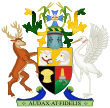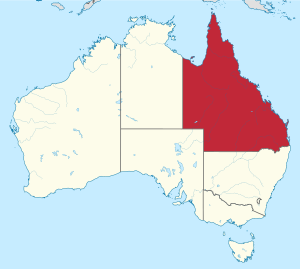
Back Queensland ACE Queensland Afrikaans ኲንዝላንድ Amharic Queensland AN Cwēneland ANG كوينزلاند Arabic كوينزلاند ARY كوينزلاند ARZ Queensland AST Kvinslend Azerbaijani
Queensland | |
|---|---|
| Nickname(s): The Sunshine State, The Smart State | |
| Motto: | |
Location of Queensland in Australia | |
| Country | Australia |
| First British settlement | September 1824 (Moreton Bay) |
| Separation from New South Wales | 6 June 1859 (as Colony of Queensland) |
| Federation | 1 January 1901 |
| Named for | Queen Victoria |
| Capital and largest city | Brisbane 27°28′08″S 153°1′25″E / 27.46889°S 153.02361°E |
| Administration | 77 local government areas |
| Demonym(s) | Queenslander |
| Government | Parliamentary constitutional monarchy |
• Monarch | Charles III |
• Governor | Jeannette Young |
• Premier | David Crisafulli (LNP) |
| Legislature | Parliament of Queensland |
| Judiciary | Supreme Court of Queensland and lower courts |
| Parliament of the Commonwealth | |
• Senate | 12 senators (of 76) |
| 30 seats (of 151) | |
| Area | |
• Land | 1,723,030[1] km2 (665,270 sq mi) |
| Highest elevation | 1,622 m (5,322 ft) |
| Population | |
• Estimate | 5,528,000 (2023)[2] |
| GSP | 2020 estimate |
• Per capita | $70,862 (5th) |
| HDI (2021) | very high · 5th |
| Time zone | UTC+10:00 (AEST) |
| Postal abbreviation | QLD |
| ISO 3166 code | AU–QLD |
| Symbols | |
| Bird | Brolga (Grus rubicunda) |
| Fish | Barrier Reef Anemone Fish (Amphiprion akindynos) |
| Flower | Cooktown orchid (Dendrobium phalaenopsis)[4] |
| Mammal | Koala (Phascolarctos cinereus) |
| Colour | Maroon |
| Fossil | Muttaburrasaurus langdoni |
| Mineral | Sapphire |
| Website | qld |
Queensland (locally /ˈkwiːnzlænd/ KWEENZ-land, commonly abbreviated as Qld)[note 1] is a state in northeastern Australia, and is the second-largest and third-most populous of the Australian states. It is bordered by the Northern Territory, South Australia and New South Wales to the west, south-west and south, respectively. To the east, Queensland is bordered by the Coral Sea and the Pacific Ocean; to the state's north is the Torres Strait, separating the Australian mainland from Papua New Guinea, and the Gulf of Carpentaria to the north-west. With an area of 1,723,030 square kilometres (665,270 sq mi), Queensland is the world's sixth-largest subnational entity; it is larger than all but 16 countries. Due to its size, Queensland's geographical features and climates are diverse, and include tropical rainforests, rivers, coral reefs, mountain ranges and white sandy beaches in its tropical and sub-tropical coastal regions, as well as deserts and savanna in the semi-arid and desert climatic regions of its interior.
Queensland has a population of over 5.5 million,[6] concentrated along the east coast, particularly in South East Queensland. The capital and largest city in the state is Brisbane, Australia's third-largest city. Ten of Australia's thirty largest cities are located in Queensland, the largest outside Brisbane being the Gold Coast, the Sunshine Coast, Townsville, Cairns, Ipswich, and Toowoomba. 24.2% of the state's population were born overseas.[7] The state has the highest inter-state net migration in Australia.[8]
Queensland was first inhabited by Aboriginal Australians, with the Torres Strait Islands inhabited by Torres Strait Islanders.[9][10] Dutch navigator Willem Janszoon, the first European to land in Australia, explored the west coast of the Cape York Peninsula in 1606. In 1770, James Cook claimed the east coast of Australia for the Kingdom of Great Britain. In 1788, Arthur Phillip founded the colony of New South Wales, which included all of what is now Queensland. Queensland was explored in subsequent decades, and the Moreton Bay Penal Settlement was established at Brisbane in 1824 by John Oxley. During the Australian frontier wars of the 19th century, colonists killed tens of thousands of Aboriginal people in Queensland while consolidating their control over the territory.
On 6 June 1859 (now commemorated as Queensland Day), Queen Victoria signed the letters patent to establish the colony of Queensland, separating it from New South Wales and thereby establishing Queensland as a self-governing Crown colony with responsible government. A large part of colonial Queensland's economy relied on blackbirded South Sea Islander slavery.[citation needed]
Queensland was among the six colonies which became the founding states of Australia with Federation on 1 January 1901. Since the Bjelke-Petersen era of the late 20th century, Queensland has received a high level of internal migration from the other states and territories of Australia and remains a popular destination for interstate migration.
Queensland has the third-largest economy among Australian states, with strengths in mining, agriculture, transportation, international education, insurance, and banking. Nicknamed the Sunshine State for its tropical and sub-tropical climates, Great Barrier Reef, and numerous beaches, tourism is also important to the state's economy.
- ^ "Area of Australia - States and Territories". Geoscience Australia. 26 July 2023. Archived from the original on 28 March 2024.
- ^ ABS National, state and territory population
- ^ "Sub-national HDI - Area Database - Global Data Lab". hdi.globaldatalab.org. Archived from the original on 23 September 2018. Retrieved 18 February 2023.
- ^ "Floral Emblem of Queensland". Australian National Botanic Gardens. Archived from the original on 8 March 2012. Retrieved 23 January 2013.
- ^ Wells, John C. (2008), Longman Pronunciation Dictionary (3rd ed.), Longman, ISBN 9781405881180
- ^ "National, state and territory population – September 2022". Australian Bureau of Statistics. 16 March 2023. Archived from the original on 16 January 2023. Retrieved 16 March 2023.
- ^ "Australia's Population by Country of Birth". Australian Bureau of Statistics. June 2023 [cited 24 April 2024]. Archived from the original on 5 December 2022.
- ^ "National, state and territory population". Australian Bureau of Statistics. March 2024 [cited 19 September 2024].
- ^ "How Old is Australia's Rock Art?". Aboriginal Art Online. Archived from the original on 4 May 2013. Retrieved 15 May 2013.
- ^ Dortch, C.E.; Hesp, Patrick A. (1994). "Rottnest Island artifacts and palaeosols in the context of Greater Swan Region prehistory". Journal of the Royal Society of Western Australia. 77. Perth: Royal Society of Western Australia: 23–32. Retrieved 1 May 2021.
Cite error: There are <ref group=note> tags on this page, but the references will not show without a {{reflist|group=note}} template (see the help page).


